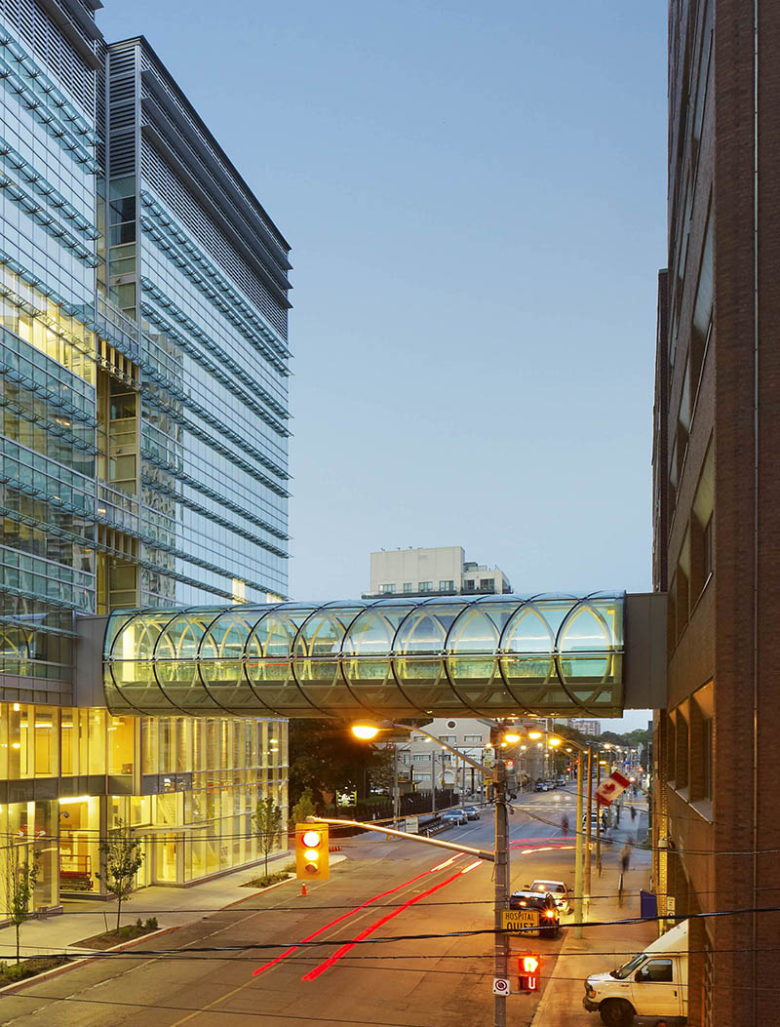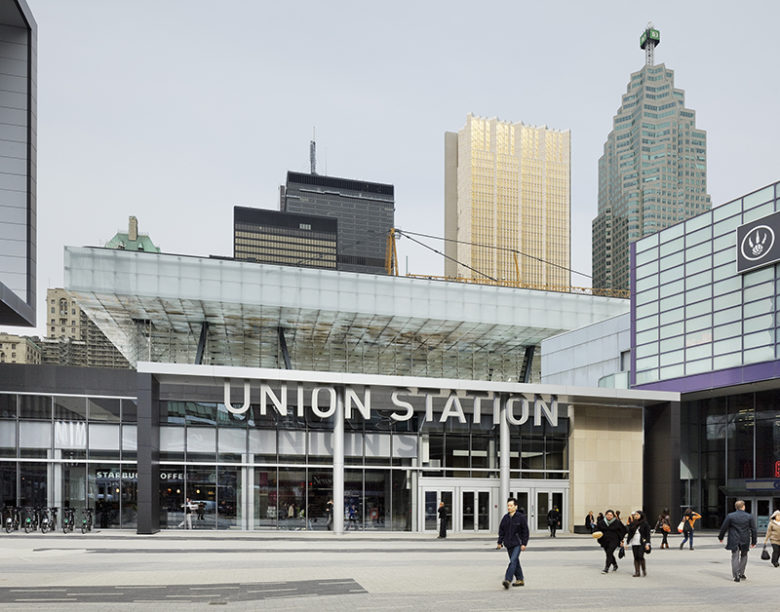Service: Vertical Transportation
St. Michael’s Hospital
Li Ka Shing Knowledge Institute
The Li Ka Shing Knowledge Institute is home to some 200 researchers, working in sophisticated laboratories and front-line clinical settings to explore both the basic dynamics of disease and the best ways to improve patient outcomes. Research is carried out in such diverse areas as multiple sclerosis, pregnancy, pediatrics and musculoskeletal disease.
A 9-storey 335,000 ft2 facility, the Li Ka Shing Knowledge Institute comprises the Keenan Research Centre and the Li Ka Shing Centre in Healthcare Education. This concrete structure is enveloped in a double-layer glass curtain wall, with a profile that reflects the academic excellence and leading-edge technology of the research and education programs within.
The research component is housed on the 209 Victoria Street site and the education component is on the 38 Shuter Street site. Linking the two sites over the Victoria Laneway is a connection housing elevators, a feature stairway, double-height lounges, conference rooms and kitchenette spaces, all designed as collision points in the building to promote information interactions and exchanges of knowledge and ideas.
The animal facility (vivarium) for larger animals includes environmentally-controlled holding areas. The animal waste disposal system cage contains washing and operating facilities, as well as an isolation area for animals entering the facility.
- Total Wet Lab Area - 3 floors at 15,000 ft2 each = 45,000 ft2
- Approximately 30% of the Research building is Wet Lab
- Vivarium on 8th floor - approximately 20,000 ft2
- Approximately 12% of research building is vivarium.
Rather than constructing small individual labs, the laboratory spaces are open concept in design, with high ceilings, to improve user comfort and access to daylight. We met the engineering challenge of designing for installation of ductwork in greatly reduced ceiling space, while still ensuring adequate air volume changes. Centrally located alcoves for dry bench work included fume hoods and lab space, designed with flexibility in mind for future uses. Likewise, the cooling system allows for spot cooling to accommodate varying equipment loads, depending on use of the space.
The vertical transportation work at Li Ka Shing featured eight passenger elevators (two being future cars and one a parking shuttle), as well as one service elevator.
SERVICES
Mechanical Engineering | Electrical Engineering | Vertical Transportation | Communications | Security | Lighting Design | Vertical Transportation Design
PROJECT FEATURES
Size: 335,000 ft2 | Status: Completed 2011
LOCATION
Toronto, Ontario
KEY SCOPE ELEMENTS
9 storey facility | Double-layer glass curtain wall | 20,000 ft2 animal vivarium for large animals |45,000 ft2 of wet lab space | Special lighting design incorporated for grand staircase and bridge connecting Li Ka Shing to St. Michael's Hospital | Vertical transportation featured 8 passenger elevators and one service elevator

Lighting to maximize common spaces
Special lighting design features for the building included the grand staircase and the bridge connecting Li Ka Shing to St. Michael’s Hospital. The lighting is controlled by a building-wide automation system.
Bangalore (Kempegowda)
International Airport
The Bangalore (Kempegowda) International Airport airport expansion will increase the airport’s capacity to at least 65 million passengers per annum. Phase 1A of the new Terminal currently includes an estimated 46 elevators, 29 escalators, and 17 moving walks.
In addition to the new Terminal, a multi-level car park is being constructed to accommodate an estimated 2438 passenger vehicles after Phase 2. In addition to the vehicle stalls, there is capacity for an estimated 450 taxi’s after Phase 2. A Metro connection to the Terminal is also planned following Phase 2 expansion, for which elevating provisions are currently being made.
HH Angus’ client is Skidmore, Owings & Merrill LLP (SOM) from New York, with whom we worked previously on a joint-venture architectural team with Adamson Associates and Moshe Safdie on Terminal 1 at Toronto Pearson International Airport.
SERVICES
Vertical Transportation
PROJECT FEATURES
Status: Ongoing
LOCATION
Bangalore, India
KEY SCOPE ELEMENTS
46 elevators | 29 escalators | 17 moving walks for new Terminal Building and multi-level car parkade for 1724 vehicles, with Phase 2 planned expansion to 2438 passenger vehicles
Penticton Regional Hospital
David E. Kampe Patient Care Tower
This project involved the design, construction, financing and maintenance of a new patient care tower at Penticton Regional Hospital.
The HH Angus team designed all new mechanical facilities – such as boiler plants and chiller plants – to post disaster requirements, in order to comply with provincial regulations. Also, BC’s Wood First Act required that sustainable materials be used throughout the building. The winning design included widespread use of wood elements to create a warm, tranquil environment for patients and visitors.
As part of Interior Health’s commitment to sustainability and green buildings, the new patient care tower was designed and constructed to achieve LEED® Gold and was certified in 2021.
In 2022, the patient care tower project and contractor EllisDon were honoured with a Silver Excellence Award from the Vancouver Regional Construction Association, in the category of ‘General Contractors - Tenant Improvement - Over $15 Million.’
SERVICES
Mechanical Engineering | Electrical Engineering | Vertical Transportation | Energy Modeling | ICAT Consulting
PROJECT FEATURES
Size: 287,500 ft2 | Status: Completed 2019
LOCATION
Penticton, British Columbia
PROJECT FEATURES
Boiler plants and chiller plants | New ambulatory care centre | 480-stall parkade | Renovations to expand ER | LEED Gold Certified

Design for comprehensive services
The Tower features an ambulatory care centre, surgical services centre, 84 medical/surgical inpatient beds in single patient rooms, a new medical device reprocessing unit, and program space for the University of British Columbia’s Faculty of Medicine.
Enabling consolidation
The Tower enhances access to services and improves patient care through consolidation of programs that were previously dispersed throughout the hospital.


New and renovated spaces
The project included two phases, Phase 1 being the design and construction of the new tower and 480-stall parkade. Phase 2 comprises renovations to the existing hospital to create an expanded ER almost four times the size of the original ER, as well as renovations to the pharmacy stores and support areas.
— Images courtesy of Mark Yoo
Michael Garron Hospital
Ken and Marilyn Thomson Patient Care Centre
Michael Garron Hospital’s new 8-storey Patient Care Centre will include inpatient and mental health beds, ambulatory clinics and an underground parkade. The project also encompasses ~100,000 ft2 of renovations within the existing hospital.
Much of the existing infrastructure at Michael Garron Hospital (MGH) has reached the end of its lifecycle, with some buildings dating to the 1920s. HH Angus was engaged as part of the Planning Design and Compliance Team (PDC) for the new Patient Care Centre, responsible for generating performance-based documents to facilitate design of the new facility.
The project specific output specifications development process included options for expanding central plant systems (heating and cooling), augmenting and unifying the campus emergency power system, replacing aged electrical substations, phasing, design standards, and technical guidelines. Incorporating operations, life cycle and maintainability requirements were of the utmost importance for this project, as responsibility for the ongoing facilities operation and maintenance will rest with MGH.
Enabling projects
To prepare the site for construction, several physical elements were relocated and/or demolished. HH Angus worked with MGH to provide mechanical and electrical engineering for the “Enabling Projects”.
These included relocation of bulk oxygen and bulk nitrous oxide, relocation of bulk chemical storage, demolition of E-Wing and F-podium, and decommissioning a major service tunnel. This work involved complex sequential construction phasing and shutdowns to maintain operation of the Hospital.
HH Angus’ ICAT group, Angus Connect, assisted MGH with development of a long-term strategic vision, directions, gap analysis, strategic recommendations and IT solution options for information technology (IT) to support the hospital moving forward. The team built upon this strategy document to develop the design specifications as part of the compliance role.
The new Patient Care Centre is Phase 1 of an ongoing redevelopment, and is targeting LEED Silver.
Image courtesy of Michael Garron Hospital.
SERVICES
PDC - Mechanical Compliance Engineering | Electrical Compliance Engineering | Vertical Transportation Design Compliance | IMIT Compliance
PROJECT FEATURES
Size: 550,000 ft2 | Status: Completion 2023
LOCATION
Toronto, Ontario
KEY SCOPE ELEMENTS
Integration of new and existing M&E and IT infrastructure | Developing long term IT strategic vision towards EMRAM 7 | Prepared PSOS for ICAT systems and integration requirements | Targeting LEED® Silver
Toronto Transit Commission
Union Station Revitalization
One goal of this revitalization project was to substantially improve public access throughout the almost century-old Union Station. To that end, numerous elevating devices were added to the site.
Union Station is Canada’s busiest rail passenger facility, handling as many as 65 million passengers annually. This number is expected to grow substantially in the future, along with expanded commuter rail and other services. To assist in improving public access, HH Angus served as the Vertical Transportation (VT) Consultants overseeing work associated with more than 30 elevators and 20 escalators that were installed at various stages of construction.
Six completely new basement traction freight elevators were installed, engineered to suit existing hoistways, which were retained from above the platform level. To meet the requirements for heritage-designated sites, new landing doors for these elevators were designed to mimic the original door panels.
Specific to GO Transit, seven new MRL (machine room-less) traction elevators were introduced, while two existing hydraulic elevators underwent major alterations, and three existing hydraulic elevators were decommissioned.
HH Angus’ scope of services extended from the Concept Design stage through to commissioning reviews performed during the Construction Administration phase.
SERVICES
Vertical Transportation Consultants
PROJECT FEATURES
Status: Completed 2018
LOCATION
Toronto, Ontario
KEY SCOPE ELEMENTS Vertical Oversaw more than 30 elevators and 20 escalators at various stages of construction | 7 new MRL traction elevators | Major alterations to 2 existing hydraulic elevators

Full range of services
Both passenger and freight elevators were included in the total VT installation, representing new equipment as well as units that were altered from prior installation.
